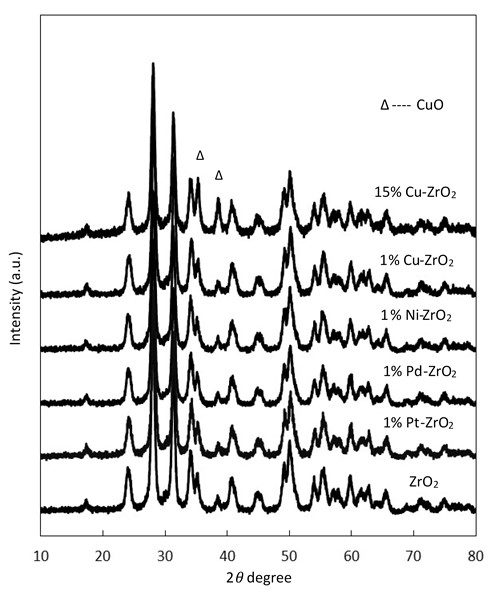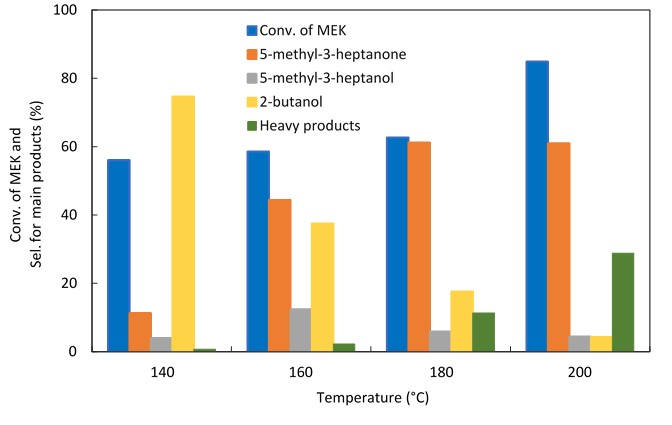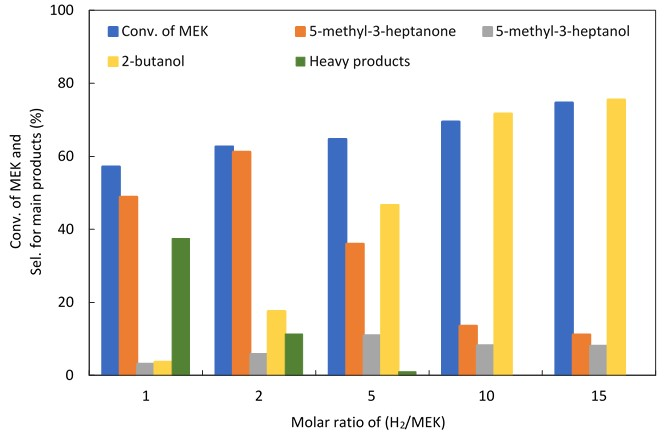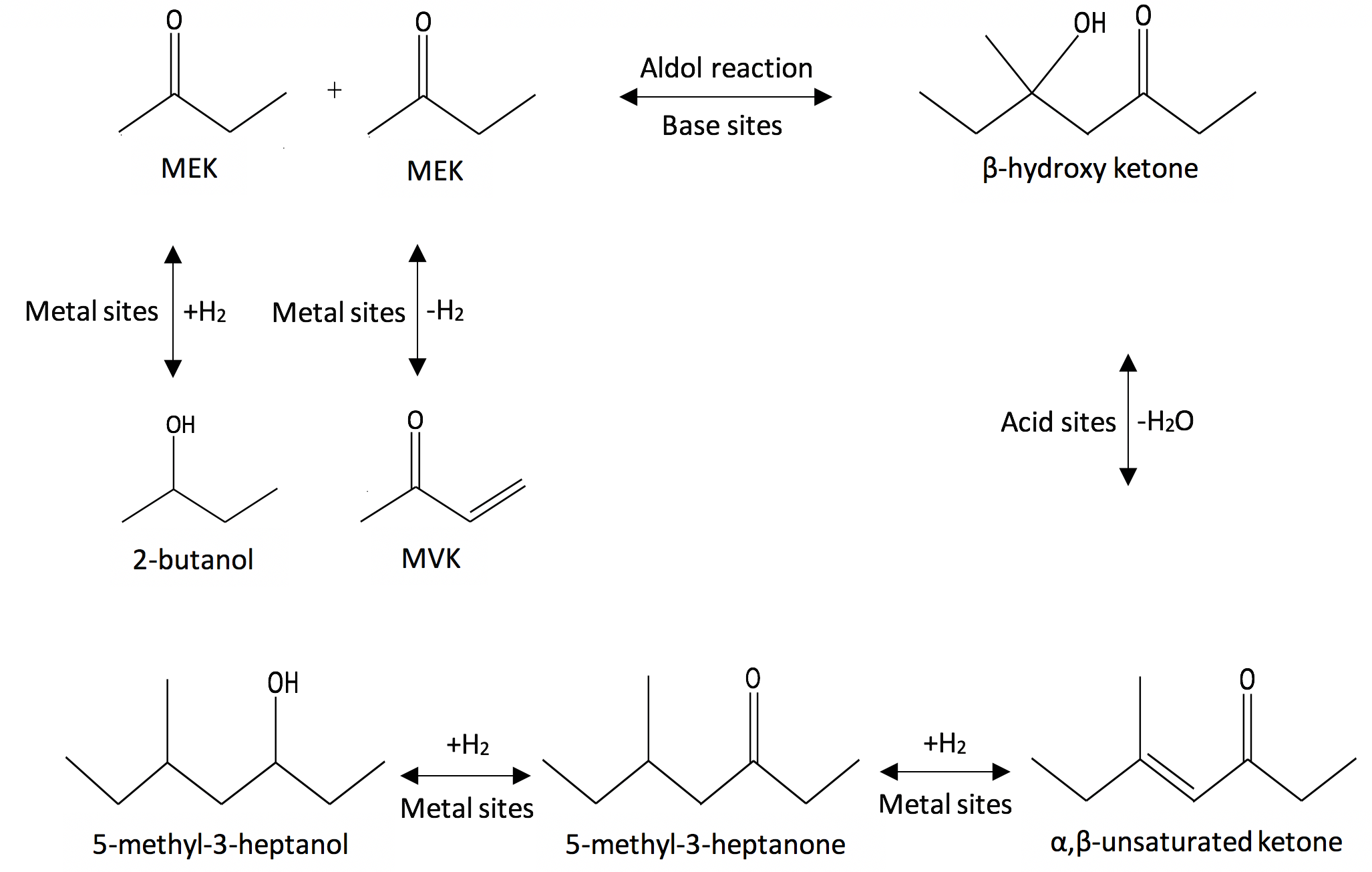Metals on ZrO2: Catalysts for the Aldol Condensation of Methyl Ethyl Ketone (MEK) to C8 Ketones
Abstract
:1. Introduction
2. Results and Discussions
2.1. Characterization of Catalysts
2.1.1. XRD
2.1.2. H2-TPR
2.1.3. NH3-TPD and CO2-TPD
2.2. Catalytic Reaction of MEK to Heavier Ketones in a Fixed Bed Reactor
2.2.1. Effect of Reaction Temperature
2.2.2. Effect of H2/MEK Molar Ratio
2.2.3. Effect of Space Time
2.2.4. Effect of Copper Loading on the Support
2.2.5. Reaction of MEK over Different Metals Loaded on ZrO2
3. Materials and Methods
3.1. Materials
3.2. Preparation of Supported Catalysts
3.3. Catalytic Reaction
3.4. Catalyst Characterization
3.4.1. X-ray Diffraction (XRD)
3.4.2. Temperature-Programed Reduction (H2-TPR)
3.4.3. Temperature-Programed Desorption (NH3-TPD) and (CO2-TPD)
4. Conclusions
Author Contributions
Funding
Conflicts of Interest
References
- Yoshikawa, N.; Yamada, Y.M.A.; Das, J.; Sasai, H.; Shibasaki, M. Direct catalytic asymmetric aldol reaction. J. Am. Chem. Soc. 1999, 121, 4168–4178. [Google Scholar] [CrossRef]
- Roelofs, J.; van Dillen, A.J.; Jong, K.P. De Base-catalyzed condensation of citral and acetone at low temperature using modified hydrotalcite catalysts. Catal. Today 2000, 60, 297–303. [Google Scholar] [CrossRef]
- Di Cosimo, J.I.; Diez, V.K.; Apesteguía, C.R. Base catalysis for the synthesis of α,β-unsaturated ketones from the vapor-phase aldol condensation of acetone. Appl. Catal. A Gen. 1996, 137, 149–166. [Google Scholar] [CrossRef]
- Nielsen, A.T.; Houlihan, W.J. The aldol condensation. Org. React. 1968, 16, 2–3. [Google Scholar]
- Kelly, G.J. Aldol Condensation Reaction and Catalyst Therefor. U.S. Patent No. 6,706,928, 16 March 2004. [Google Scholar]
- Melo, L.; Giannetto, G.; Alvarez, F.; Magnoux, P.; Guisnet, M. Effect of the metallic/acid site (nPt/nA) ratio on the transformation of acetone towards methyl isobutyl ketone. Catal. Lett. 1997, 44, 201–204. [Google Scholar] [CrossRef]
- Reichle, W.T. Catalytic Aldol Condensations. U.S. Patent No. 4,165,339, 21 August 1979. [Google Scholar]
- Vannice, M.A.; Sen, B. Metal-support effects on the intramolecular selectivity of crotonaldehyde hydrogenation over platinum. J. Catal. 1989, 115, 65–78. [Google Scholar] [CrossRef]
- Claus, P. Selective hydrogenation of ά,β-unsaturated aldehydes and other C=O and C=C bonds containing compounds. Top. Catal. 1998, 5, 51–62. [Google Scholar] [CrossRef]
- Zhu, L.; Lu, J.Q.; Chen, P.; Hong, X.; Xie, G.Q.; Hu, G.S.; Luo, M.F. A comparative study on Pt/CeO2 and Pt/ZrO2 catalysts for crotonaldehyde hydrogenation. J. Mol. Catal. A Chem. 2012, 361, 52–57. [Google Scholar] [CrossRef]
- Gallezot, P.; Richard, D. Selective hydrogenation of α,β-unsaturated aldehydes. Catal. Rev. 1998, 40, 81–126. [Google Scholar] [CrossRef]
- Mohr, C.; Claus, P. Hydrogenation properties of supported nanosized gold particles. Sci. Prog. 2001, 84, 311–334. [Google Scholar] [CrossRef]
- Sul’man, E. Selective hydrogenation of unsaturated ketones and acetylene alcohols. Russ. Chem. Rev. 1994, 63, 923–936. [Google Scholar] [CrossRef]
- Szöllősi, G.; Mastalir, A.; Molnár, Á.; Bartók, M. Hydrogenation of α,β-unsaturated ketones on metal catalysts. React. Kinet. Catal. Lett. 1996, 57, 29–36. [Google Scholar] [CrossRef]
- Ravasio, N.; Antenori, M.; Gargano, M.; Rossi, M. Chemoselectivity and regioselectivity in the hydrogenation of α,β-unsaturated carbonyl compounds promoted by Cu/Al2O3. J. Mol. Catal. 1992, 74, 267–274. [Google Scholar] [CrossRef]
- Ravasio, N.; Antenori, M.; Gargano, M.; Mastrorilli, P. CuSiO2: An improved catalyst for the chemoselective hydrogenation of α,β-unsaturated ketones. Tetrahedron Lett. 1996, 37, 3529–3532. [Google Scholar] [CrossRef]
- Molnár, Á.; Bucsi, I.; Bartók, M. Pinacol Rearrangement on Zeolites. Stud. Surf. Sci. Catal. 1988, 41, 203–210. [Google Scholar]
- Multer, A.; McGraw, N.; Hohn, K.; Vadlani, P. Production of methyl ethyl ketone from biomass using a hybrid biochemical/catalytic approach. Ind. Eng. Chem. Res. 2012, 52, 56–60. [Google Scholar] [CrossRef] [Green Version]
- Emerson, R.R.; Flickinger, M.C.; Tsao, G.T. Kinetics of dehydration of aqueous 2,3-butanediol to methyl ethyl ketone. Ind. Eng. Chem. Prod. Res. Dev. 1982, 21, 473–477. [Google Scholar] [CrossRef]
- Zhang, W.; Yu, D.; Ji, X.; Huang, H. Efficient dehydration of bio-based 2,3-butanediol to butanone over boric acid modified HZSM-5 zeolites. Green Chem. 2012, 14, 3441–3450. [Google Scholar] [CrossRef]
- Bucsi, I.; Molnár, Á.; Bartók, M.; Olah, G.A. Transformation of 1,2-diols over perfluorinated resinsulfonic acids (Nafion-H). Tetrahedron 1994, 50, 8195–8202. [Google Scholar] [CrossRef]
- Török, B.; Bucsi, I.; Beregszászi, T.; Kapocsi, I.; Molnár, Á. Transformation of diols in the presence of heteropoly acids under homogeneous and heterogeneous conditions. J. Mol. Catal. A Chem. 1996, 107, 305–311. [Google Scholar] [CrossRef]
- Nikitina, M.A.; Ivanova, I.I. Conversion of 2,3-Butanediol over Phosphate Catalysts. ChemCatChem 2016, 8, 1346–1353. [Google Scholar] [CrossRef]
- Lee, J.; Grutzner, J.B.; Walters, W.E.; Delgass, W.N. The conversion of 2,3-butanediol to methyl ethyl ketone over zeolites. Stud. Surf. Sci. Catal. 2000, 130, 2603–2608. [Google Scholar]
- Yu, E.K.; Saddler, J.N. Fed-batch approach to production of 2,3-butanediol by Klebsiella pneumoniae grown on high substrate concentrations. Appl. Environ. Microbiol. 1983, 46, 630–635. [Google Scholar] [PubMed]
- Zeng, A.P.; Biebl, H.; Deckwer, W.D. Effect of pH and acetic acid on growth and 2,3-butanediol production of Enterobacter aerogenes in continuous culture. Appl. Microbiol. Biotechnol. 1990, 33, 485–489. [Google Scholar] [CrossRef]
- Mas, C. De; Jansen, N.B.; Tsao, G.T. Production of optically active 2,3-butanediol by Bacillus polymyxa. Biotechnol. Bioeng. 1988, 31, 366–377. [Google Scholar] [CrossRef] [PubMed]
- Ledingham, G.A.; Neish, A.C. Fermentative Production of 2.3 Butanediol Industrial Fermentations; Underkofler, L.A., Hickey, R.J., Eds.; Chemical Publishing Co: New York, USA, 1954; Volume 2, pp. 27–93. [Google Scholar]
- Jansen, N.B.; Flickinger, M.C.; Tsao, G.T. Production of 2,3-butanediol from D-xylose by Klebsiella oxytoca ATCC 8724. Biotechnol. Bioeng. 1984, 26, 362–369. [Google Scholar] [CrossRef] [PubMed]
- Qureshi, N.; Cheryan, M. Effects of aeration on 2,3-butanediol production from glucose by Klebsiella oxytoca. J. Ferment. Bioeng. 1989, 67, 415–418. [Google Scholar] [CrossRef]
- Ji, X.J.; Huang, H.; Du, J.; Zhu, J.G.; Ren, L.J.; Hu, N.; Li, S. Enhanced 2,3-butanediol production by Klebsiella oxytoca using a two-stage agitation speed control strategy. Bioresour. Technol. 2009, 100, 3410–3414. [Google Scholar] [CrossRef]
- Saha, B.C.; Bothast, R.J. Production of 2,3-butanediol by newly isolated Enterobacter cloacae. Appl. Microbiol. Biotechnol. 1999, 52, 321–326. [Google Scholar] [CrossRef]
- Hattori, H. Heterogeneous basic catalysis. Chem. Rev. 1995, 95, 537–558. [Google Scholar] [CrossRef]
- Yamaguchi, T.; Nakano, Y.; Iizuka, T.; Tanabe, K. Catalytic activity of ZrO2 and ThO2 for HD exchange reaction between methyl group of adsorbed isopropyl alcohol-d8 and surface OH group. Chem. Lett. 1976, 677–678. [Google Scholar] [CrossRef]
- Chary, K.V.R.; Sagar, G.V.; Srikanth, C.S.; Rao, V.V. Characterization and catalytic functionalities of copper oxide catalysts supported on zirconia. J. Phys. Chem. B 2007, 111, 543–550. [Google Scholar] [CrossRef]
- Sagar, G.V.; Rao, P.V.R.; Srikanth, C.S.; Chary, K.V.R. Dispersion and Reactivity of Copper Catalysts Supported on Al2O3–ZrO2. J. Phys. Chem. B 2006, 110, 13881–13888. [Google Scholar] [CrossRef] [PubMed]
- Van der Grift, C.J.G.; Mulder, A.; Geus, J.W. Characterization of silica-supported copper catalysts by means of temperature-programmed reduction. Appl. Catal. 1990, 60, 181–192. [Google Scholar] [CrossRef]
- Shimokawabe, M.; Asakawa, H.; Takezawa, N. Characterization of copper/zirconia catalysts prepared by an impregnation method. Appl. Catal. 1990, 59, 45–58. [Google Scholar] [CrossRef]
- Dow, W.P.; Wang, Y.P.; Huang, T.J. Yttria-stabilized zirconia supported copper oxide catalyst: I. Effect of oxygen vacancy of support on copper oxide reduction. J. Catal. 1996, 160, 155–170. [Google Scholar] [CrossRef]
- Robertson, S.D.; McNicol, B.D.; De Baas, J.H.; Kloet, S.C.; Jenkins, J.W. Determination of reducibility and identification of alloying in copper-nickel-on-silica catalysts by temperature-programmed reduction. J. Catal. 1975, 37, 424–431. [Google Scholar] [CrossRef]
- Li, Z.; Hu, X.; Zhang, L.; Liu, S.; Lu, G. Steam reforming of acetic acid over Ni/ZrO2 catalysts: Effects of nickel loading and particle size on product distribution and coke formation. Appl. Catal. A Gen. 2012, 417, 281–289. [Google Scholar] [CrossRef]
- Roh, H.S.; Jun, K.W.; Dong, W.S.; Chang, J.S.; Park, S.E.; Joe, Y.I. Highly active and stable Ni/Ce–ZrO2 catalyst for H2 production from methane. J. Mol. Catal. A Chem. 2002, 181, 137–142. [Google Scholar] [CrossRef]
- Song, Y.Q.; Liu, H.M.; He, D.H. Effects of hydrothermal conditions of ZrO2 on catalyst properties and catalytic performances of Ni/ZrO2 in the partial oxidation of methane. Energy Fuels. 2010, 24, 2817–2824. [Google Scholar] [CrossRef]
- Sun, L.; Tan, Y.; Zhang, Q.; Xie, H.; Han, Y. Tri-reforming of coal bed methane to syngas over the Ni-Mg-ZrO2 catalyst. J. Fuel Chem. Technol. 2012, 40, 831–837. [Google Scholar] [CrossRef]
- Chen, S.; Luo, L.; Cheng, X. Influence of preparation method on the performance of Pd/ZrO2-Al2O3 catalysts for HDS. Indian J. Chem. Technol. 2009, 16, 272–277. [Google Scholar]
- Ivanova, A.S.; Slavinskaya, E.M.; Gulyaev, R.V.; Zaikovskii, V.I.; Stonkus, O.A.; Danilova, I.G.; Plyasova, L.M.; Polukhina, I.A.; Boronin, A.I. Metal–support interactions in Pt/Al2O3 and Pd/Al2O3 catalysts for CO oxidation. Appl. Catal. B Environ. 2010, 97, 57–71. [Google Scholar] [CrossRef]
- Lee, H.C.; Lee, D.; Lim, O.Y.; Kim, S.; Kim, Y.T.; Ko, E.Y.; Park, E.D. ZrO2-supported Pt catalysts for water gas shift reaction and their non-pyrophoric property. Stud. Surf. Sci. Catal. 2007, 167, 201–206. [Google Scholar]
- Kozlowski, J.T.; Davis, R.J. Heterogeneous catalysts for the Guerbet coupling of alcohols. ACS Catal. 2013, 3, 1588–1600. [Google Scholar] [CrossRef]
- Gabriëls, D.; Hernández, W.Y.; Sels, B.; Van Der Voort, P.; Verberckmoes, A. Review of catalytic systems and thermodynamics for the Guerbet condensation reaction and challenges for biomass valorization. Catal. Sci. Technol. 2015, 5, 3876–3902. [Google Scholar] [CrossRef] [Green Version]









| Catalyst | H2 Uptake mmol/g | NH3 Uptake mmol/g | CO2 Uptake mmol/g |
|---|---|---|---|
| ZrO2 | _ | 0.12 | 0.053 |
| 15% Cu–ZrO2 | 1.46 | 0.27 | 0.092 |
| 1% Cu–ZrO2 | 0.17 | 0.17 | 0.075 |
| 1% Ni–ZrO2 | 0.18 | 0.15 | 0.064 |
| 1% Pd–ZrO2 | 0.05 | 0.16 | 0.071 |
| 1% Pt–ZrO2 | 0.13 | 0.16 | 0.066 |
| Catalysts | Conv. of MEK (%) | Sel. of 2-Butanol (%) | Sel. of C8 Ketone (%) | Sel. of C8 Alcohol (%) | Others (%) |
|---|---|---|---|---|---|
| ZrO2 | 26 | 0 | 5 | 0 | 95 a |
| 1% Cu–ZrO2 | 78 | 12 | 64 | 7 | 17 b |
| 15% Cu–ZrO2 | 63 | 18 | 61 | 6 | 15 b |
© 2018 by the authors. Licensee MDPI, Basel, Switzerland. This article is an open access article distributed under the terms and conditions of the Creative Commons Attribution (CC BY) license (http://creativecommons.org/licenses/by/4.0/).
Share and Cite
Al-Auda, Z.; Al-Atabi, H.; Hohn, K.L. Metals on ZrO2: Catalysts for the Aldol Condensation of Methyl Ethyl Ketone (MEK) to C8 Ketones. Catalysts 2018, 8, 622. https://doi.org/10.3390/catal8120622
Al-Auda Z, Al-Atabi H, Hohn KL. Metals on ZrO2: Catalysts for the Aldol Condensation of Methyl Ethyl Ketone (MEK) to C8 Ketones. Catalysts. 2018; 8(12):622. https://doi.org/10.3390/catal8120622
Chicago/Turabian StyleAl-Auda, Zahraa, Hayder Al-Atabi, and Keith L. Hohn. 2018. "Metals on ZrO2: Catalysts for the Aldol Condensation of Methyl Ethyl Ketone (MEK) to C8 Ketones" Catalysts 8, no. 12: 622. https://doi.org/10.3390/catal8120622
APA StyleAl-Auda, Z., Al-Atabi, H., & Hohn, K. L. (2018). Metals on ZrO2: Catalysts for the Aldol Condensation of Methyl Ethyl Ketone (MEK) to C8 Ketones. Catalysts, 8(12), 622. https://doi.org/10.3390/catal8120622






